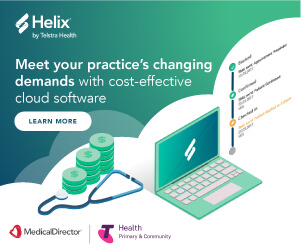Innovation in healthcare comes at a cost. Are we willing to pay for it?
Written by Dr Charlotte Middleton. Originally appeared on LinkedIn, reposted here with permission.
Last month, MedicalDirector launched an industry first: a fully-integrated tool that can produce quick and effective care plans for patients with chronic illness.
MedicalDirector Care was developed in consultation with GPs, practice nurses and managers, and employs smart algorithms to contextualise the care plan creation process.
It’s a huge win for time-poor GPs and practice staff, who can now create professional-looking, comprehensive care plans within their clinical software.
And for patients with chronic illness, many of whom have been reluctant to visit a medical practice during the COVID-19 pandemic, they walk away with a clear understanding of how their health needs will be met.
Why we need to focus on innovation
Improving what we do and how we do it should be a constant driver for all participants in the medical industry if we are to see more Australians having access to improved coordinated care.
GPs and medical practices are under a lot of pressure to deliver healthcare more efficiently, and one way that software providers can support the work that we do, is by focusing on innovation.
As a GP who has worked with numerous software providers throughout my career, I know that, feature-for-feature, many of the software platforms available to general practice are comparable.
When we choose a clinical software platform, there is a ‘bare minimum’ expectation. We need it to support our practices clinically and administratively. Our practice staff must have the ability to book appointments, batch Medicare items, bill patients, send reminders and reconcile daily reports.
Of course, we require core clinical functionality too – the ability to record and review patient notes, order pathology and radiology, write prescriptions and refer patients to our specialist and allied health colleagues. These are minimum bases for engagement.
But, so often we hear our colleagues call out for greater innovation in healthcare – interoperability, connectivity, increased medicines safety, improved data quality and digitally-enhanced models of care; and we echo those sentiments ourselves.
While it’s reasonable to expect that minor updates and features can be delivered without passing on extra costs to the end user, we must be careful not to undermine the value of innovation by expecting completely new and advanced tools to be free to use.
Innovation is complex
Innovation in healthcare is complex, fast-paced (particularly during a pandemic) and open to serious risks that must be managed appropriately.
For a solution to be considered innovative, it needs to be significantly different and more advanced than what currently exists in the market. It has to provide a clear benefit to patients and practitioners alike, and it must meet the demands of all stakeholders, including government and regulatory bodies.
Once a solution is ready to be launched, it’s not just a matter of making it available to users and hoping for the best. It needs to be delivered with the appropriate level of education and knowledge-sharing, and be open to ongoing feedback and refinements.
By thinking about what we consider innovative as well as the complexities involved in delivering innovation, then we, as consumers, will place greater value on those efforts which aim to bring about worthwhile change in our industry.
I believe that any major, transformative change comes at a cost. And unless we invest significant resources to build, test and deliver, we’ll continue to fall short of delivering real results.
MedicalDirector is leading the way
As Chief Medical Officer of MedicalDirector, I can confidently say that our team is at the forefront of healthcare innovation in Australia – not just providing the bare minimum essentials for clinical software.
In March 2020, the world was thrust into a pandemic and clinical practice as we know it hasn’t been the same since. In less than two weeks, MedicalDirector built and delivered fully integrated voice and video teleconsults, accessible from within the patient record, for free.
MedicalDirector also maintains a fully integrated, proprietary medicines information database, AusDI, to support excellence in clinical decision-making.
And nearly five years ago, MedicalDirector was the first to develop cloud-based clinical software offering security, mobility and clinical excellence. The platform is supported by new feature releases fortnightly, and is designed in consultation with GPs, to meet the ever-evolving needs of our practices. Only now, in 2020, are other clinical software providers starting to invest in cloud technology too.
MedicalDirector Care is the latest addition to a long list of innovations that provide new levels of efficiency and support critical services in our community.
Where do we want to go next?
Many of us have been dealing with non-stop change since March, having had to quickly adapt to a COVID-19 world. As it becomes evident that our ‘new normal’ will continue to include different ways of delivering healthcare such as telehealth, many of us are wondering what the future of general practice looks like.
The healthcare innovation that was once considered ‘nice to have’ is becoming crucial for the effective delivery of healthcare in Australia. For me, I’d like to see even more technology and innovation be made available to all. But for this to happen, we must be prepared to pay for it.
Because when it comes to innovation, the cost we need to talk about is the cost of not doing anything at all.









